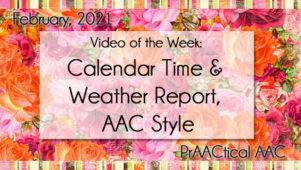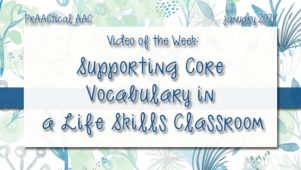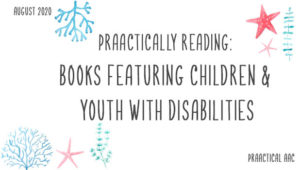PrAACtically Reading with Karen Natoci: Apples
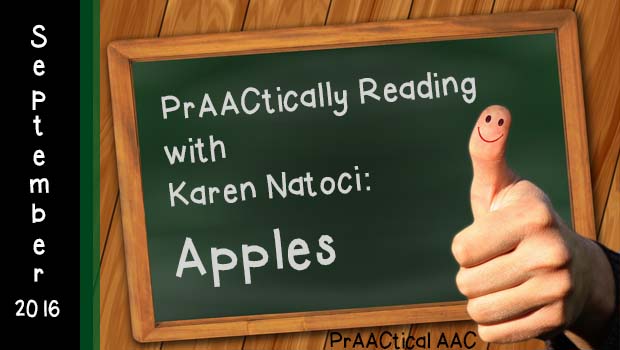
 We are so happy to welcome back SLP Karen Natoci who graciously agreed to continue writing about how she uses interactive book reading to build language skills with beginning communicators. You can see her earlier posts in the PrAACtically Reading series here. In this post, she shares activity ideas for two books on apples. You can learn more about Karen and download her materials toward the bottom of the post. Enjoy!
We are so happy to welcome back SLP Karen Natoci who graciously agreed to continue writing about how she uses interactive book reading to build language skills with beginning communicators. You can see her earlier posts in the PrAACtically Reading series here. In this post, she shares activity ideas for two books on apples. You can learn more about Karen and download her materials toward the bottom of the post. Enjoy!
:::::::::::::::::::::::::::::::::::::::::::::::::::::::::
Books: Apples by Ken Robbins and Apples for Everyone by Jill Esbaum
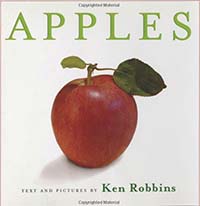
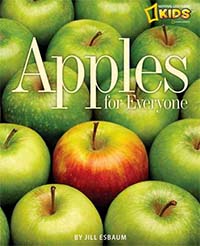
Adapted and simplified Powerpoint Book Apples by Karen Natoci
Core Vocabulary focus: here, in, where
Additional Vocabulary focus: Body parts; red, round, yellow, green,
COMMUNICATION Matrix (Rowland, 2009) Level: I-VII (all levels!)
————————————————————————————————————————————-
It is September and apple time! I chose to feature these books from which to adapt material suitable for students with complex communication needs. I have a simplified power point book, which offers the language and images at a very simple level. The core vocabulary words are underlined. First and foremost, during shared reading, the goal is to provide a supported or nearly independent means of Communication for all children to foster engagement from the student who is just beginning to use AAC.
To promote the students’ participation, I tend not to have them use their most difficult AAC systems as I want to emphasize engagement, fluency and success. During the reading, the level of prompting used is “expectant pausing” while limiting direct physical or verbal prompting whenever possible. These stories do not have repeated lines so programming big macs, sequencers may involve the use of KEY WORDS from the story at the single word, phrase or sentence level. Comments can be programed into devices as follows:
- I like that!
- What’s next?
- Show me!
- Again!
The framework from which this multi-sensory approach to reading stems from the work of Dr. Betty Bunce in her book, Early Literacy in Action: The Language-Focused Curriculum for Preschool. In order to further adapt the thematic unit for our students, the ten conditions that support learning over time (Erickson and Koppenhaver, Emergent Literacy Summer Academy, 2016) are considered:
- Knowledgeable Others
- Be an enthusiastic reader who knows more about the topic than the students do!
- Interactive Communication and Participation
- While reading a story, know how to foster the level of participation that your students are capable of contributing so that the reading is not too one-sided
- Example, students learning to use a single switch may need a very obvious, overt, expectant pause to realize that it is their turn to engage with the story,
- Linger with objects and images to give students the time they need to access it (i.e., if showing the student an image from the book, hold it steadily in their visual field, augment it visually if needed and give your student time to look at it)
- Do not rush!
- Repetition with Variety
- read the same story daily with slight variances in the routine such as
- start with real apples on the first few readings,
- replace with 2-dimensional apples the next few readings,
- then, include text (limit to the word “APPLE”)
- if integrating with math add the counting of apples, include the numerals, 1, 2, 3
- if integrating with math concepts encourage recognition of “one apple” versus “many apples” or consider a subitized representation of {*}, {**} and {***}
- or, read different stories but all on the same topic (APPLES)
- participation: offer your students the opportunity comment on a picture in the book (if reading from the original texts, above)
- focus: emphasize a different part of the story each day,
- interaction: bring something unique to the sharing of the story each day (i.e., if the story is about bugs, bring in a real bug!)
- Cognitive Engagement
- Are the listeners engaged?
- Multi-sensory?
- Is the reader and support team able to:
- Navigate an increase or decrease in difficulty in the moment (based on the student’s need)?
- Follow a prompt hierarchy?
- Limit distractions?
- Considerations for those with hearing impairment?
- Cognitive Clarity
- Say out loud why we are reading stories with apples
- Personal Connection with the Curriculum
- Find out each student’s real life experience with apples
- Comprehensive Instruction
- Cover all of the senses,
- Use apples across many subject areas and experiences: math, charts, counting, sorting, categorizing, writing, art, music
- Significant Time Allocation
- This is easy to do when the subject/topic is meaningful with comprehensive instruction,
- High Expectations and Low Standards
- Expect all of the above when students have an AAC system allowing them to be engaged
- read the same story daily with slight variances in the routine such as
- While reading a story, know how to foster the level of participation that your students are capable of contributing so that the reading is not too one-sided
Implementation will involve multi-sensory input (described in detail below) with the inclusion of literacy (ABC/Word knowledge) and pausing to acknowledge any all expressive means of communication (using aided and unaided means).
VISUAL:
To help children with cortical vision impairment or who need visual enhancements, considerations of a hierarchy of visual complexity is encouraged:
- If the book contains a photo of many apples, Consider cutting out a couple of apples from the page and LIFT it onto a black background.
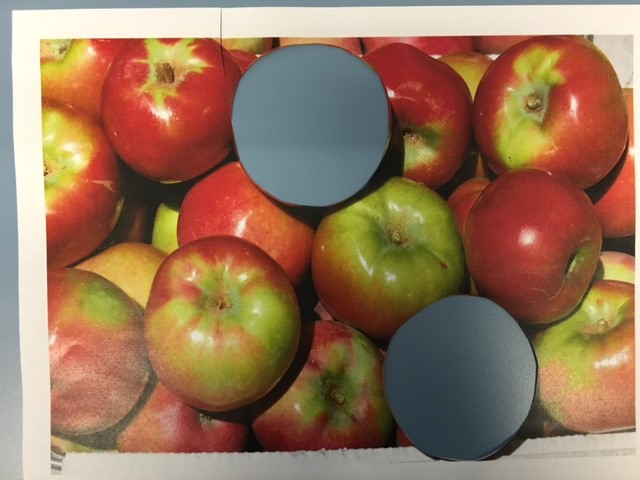
- Isolate the image.
- Present to the child’s visual field.
- Increase difficulty by presenting near the child’s visual field (by about 10 degrees) and allow them to visually locate it,
- Augment with lighting, careful not to add glare,
- Label what they see using clear, simple language,
- Consider following a general hierarchy of 2-dimensional visual complexity as follows:
- Photo of apple in isolation in a black background,

- Photo of apple in isolation without any background clutter (other color background). A simple schematic picture of an apple may also work,

- Photo of more than one apple presented without overlap,
- Photo of whole apple with more context, such as on a cutting board,
- Photo of whole apples placed in a basket,
- Photos of parts of apples (sliced, presented in different angles)
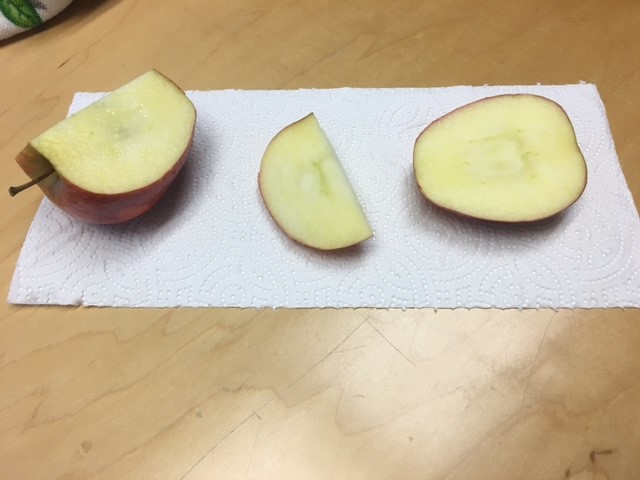
- Photos of apples, parts of apples, overlapping views with more complexity, against other objects (such as a photo of apple slices on the kitchen counter with other kitchen items in the background
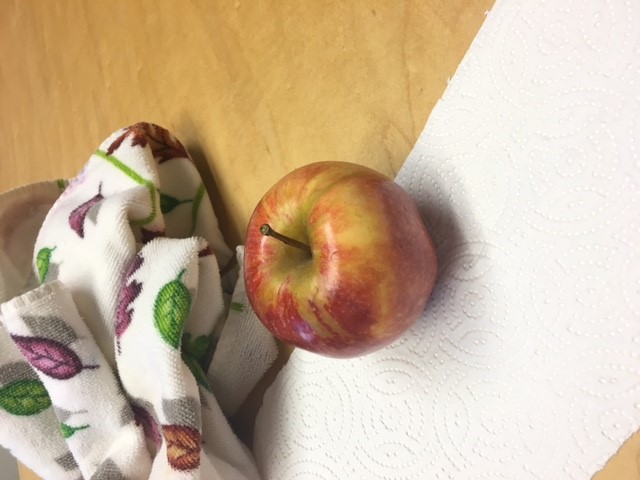
- Photo of whole apples hanging on the tree (green on green the most difficult)

Compare photo of a pile of apples to an isolated apple to see the two ends of the visual hierarchy at the same time:
OLFACTORY:
Provide smells of apples:
- raw,
- applesauce,
- apple pie, (in context)
TOUCH:
- provide tactile feeling of
- the outside (skin) of the apple,
- a less than perfect apple (soft, bumpy)
- the inside of the apple
- provide tactile feeling of applesauce
TASTE:
- taste apples presented in various forms with full consideration of feeding and swallowing safety guidelines
HEAR:
- hear the sound of an apple as it falls to the floor,
- hear the difference between a single apple falling versus a lot of apples falling,
- Hear the sound of a “crunch!” while someone is eating an apple
Write about it by by filling out this worksheet: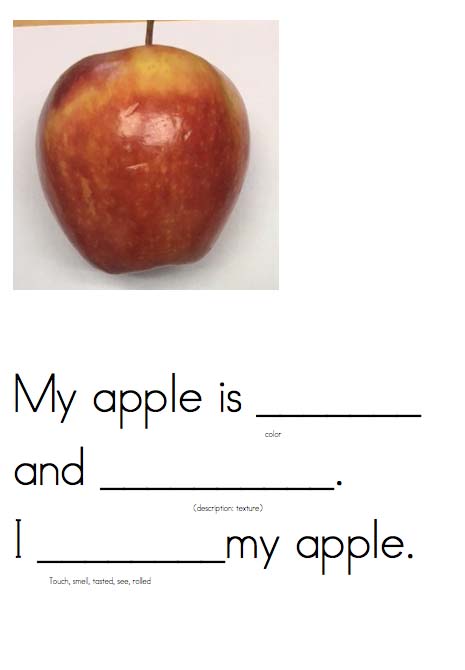
Listen/WORD KNOWLEDGE:
- Sing and clap the “apple” song (sung to ‘B-I-N-G-O”)
- Look at the word apple, show letters (point) while singing,
- Talk about the letters in the word, APPLE
- Unscramble the word,
- Look at the shape of the word with two “p” letters in the middle,
- Say the sounds in the word, APPLE
- Look at the word apple written using a variety of fonts/print
- Find the word apple
- Write the word apple
You can download the adapted PowerPoint version of the book here.
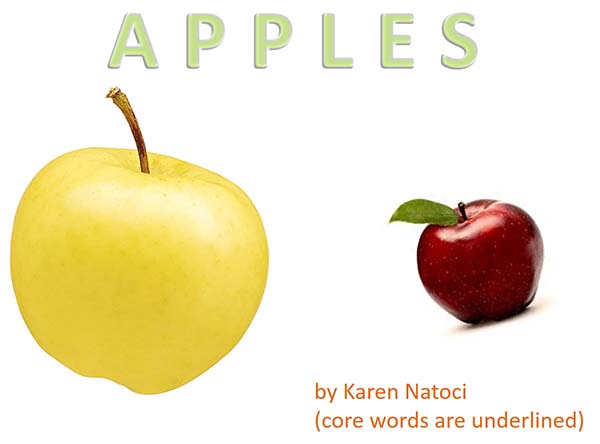
The Apple Song (to the tune of “B-I-N-G-O”) visual support, the worksheet, and the high-contrast symbols are available here.
REFERENCES:
Bunce, B. (2008). Early literacy in action: The language-focused curriculum for preschool. Baltimore, MD: Paul H. Brookes Publishing Co.
Clements, D. & Sarama, J. (2014). Learning and teaching early math: The learning trajectories approach, 2nd Edition. NYC: Rutledge.
Erickson, K., & Koppenhaver, D. (August, 2016). Emergent Literacy Summer Academy, Oakland Schools, Waterford, MI.
Project Core. (2016). Universal Core Vocabulary Communication System, 36-location high contrast core board retrieved from https://www.dropbox.com/s/1qnnv4mzpmqkbqe/36_Personal_Use_High_Contrast_060616.pdf?dl=0
Roman-Lantzy, C. (2007) Cortical visual impairment: An approach to assessment and intervention. NYC: American Federation for the Blind Press.
About Karen Natoci: Karen earned both her undergraduate and graduate degrees from the University of Michigan in the area of Psychology, Speech/Hearing Science, and Speech and Language Pathology in 1982. Karen has always been drawn to those with complex communication needs. For years, she held a private practice working with the most physically and communicatively challenged survivors of acquired traumatic brain injury. She was excited by the potential of the new field of AAC and how it enhanced the communication of those with Complex Communication Needs. Karen spent 15 wonderful years at Wing Lake Developmental Center in the Bloomfield Hills School district and was a part time lecturer at Wayne State University, College of Special Education for 9 years. She spent part of this year at Oregon Health and Science University wrapping up her consulting role as a charter member of the Communication Matrix, Community of Practice before moving to begin her new position as the Director of Education at The Bridge School in Hillsborough, California. Karen follows an “integrationist” approach in the area of early AAC, pulling from multiple sources of information and research with the ultimate goal to enhance communication and engagement with learners with the most complex of needs. At the end of the day, Karen enjoys practicing piano and exploring her new surroundings in the San Francisco Bay area.
Filed under: Featured Posts, PrAACtical Thinking
Tagged With: classroom, implementation, literacy, reading
This post was written by Carole Zangari

